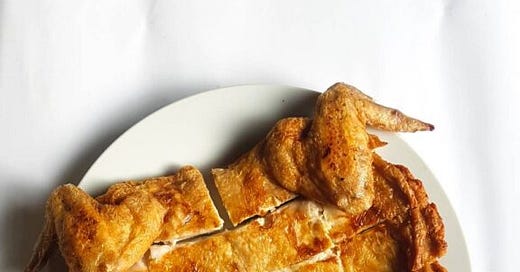Last year, when I was back in Singapore, my family and I had dinner at Whampoa Keng. Steamboat restaurants in Singapore are a dime a dozen, but what makes this family-run business stand out is their specialization in Teochew-style steamboat. Heated in a traditional hotpot filled with hot coals to keep the soup warm, the cloudy fish broth is always reliably rich and comforting, with a sour plum or two added to whet the appetite. That visit, I encountered something I had not noticed before on the menu – going by the name of Jin Long Ji, literally translated as golden dragon chicken, though the English name provided was Golden Phoenix Chicken.
It arrived at the table resembling a crispy Korean pancake, topped with a heap of keropok and chilli dipping sauce. It turned out to be a curious combination of squid paste moulded onto the skin of a chicken, the whole thing deep-fried until the skin crunched like a potato chip.
I later found out, upon doing some research at home, that Golden Dragon chicken used to be a wildly popular dish in Singapore back in the day. Its laborious nature led to its demise, the few restaurants that now serve it charging exorbitant prices for that same reason. It also happens to be a controversial dish, especially if one is not aware of what the dish actually is. I have seen reviews online panning the dish for being somewhat deceptive, not being entirely composed of chicken. Despite any misgivings one may have of this dish, it is impossible to deny the skill and creativity involved in the creation of this dish. The heavenly king, whichever one of the four invented this dish, managed to lift something familiar and even a little mundane almost beyond recognition in form.
This is classic Cantonese cuisine, that you can’t find at any simple eatery. One that requires real skill and technique to separate the skin from the carcass in a single piece, with no holes! And as much as I enjoy extracting every last shred of meat from bones, sometimes its nice to not have to.
Golden Dragon Chicken
1 chicken
1 egg white
1 tablespoon sesame oil
3 teaspoons sugar
3 teaspoons salt
2 tablespoons finely sliced spring onions
500g skinless boneless chicken (breast or thigh meat), cut into chunks
300g prawns, shelled and deveined, cut into chunks
Oil for deep-frying
The most tedious part of this recipe is removing the chicken skin from the carcass. The goal is for it to be removed in a single piece with no holes. Run a sharp knife down the skin between the two chicken breasts. You can also use a pair of scissors for this. Gently pull the skin away from the slit. If you come across any transparent connective tissue membranes, you can break them apart with your fingers or cut through gently with a knife.
We are keeping the wings on the skin, as they cannot be removed easily. Once the chicken skin has been pulled down from the breasts, cut at the joint between the chicken breast and wings to release the two wings from the carcass.
Now that the wings are disconnected from the carcass, begin separating the skin from the backbone, using fingers or a knife. Work your way down the backbone, being careful not to rip the skin. You want to hold the chicken’s skin in your dominant hand, and grip knife in the other hand. Use your knife to aid you in separating the skin from carcass, making sure to make small cuts at an angle and being extra careful to not pierce the chicken skin.
The skin should now be connected to the carcass at the ends of both drumsticks and the parson’s nose. Pull the skin away from the legs, as much as possible to get as much skin off. Cut the skin at the two ends of the drumstick and at the parson’s nose to completely free the skin from the carcass. Now you would have a skinless chicken carcass and a whole piece of chicken skin. There will be some excess fat at the bottom of the skin. Trim that off and the skin is ready to be stuffed.
To make the paste, grind up the chicken (I used 2 chicken breasts from the chicken in this video, but I would recommend using skinless boneless chicken thighs if you have them for extra succulence). Place them in a food processor or blender with the egg white, spring onions, salt, sugar and sesame oil. Grind until smooth then add the prawns and pulse until the prawns are coarsely ground.
Flip the chicken skin over and smear the prawn paste all over it evenly. Using a wet spoon will prevent the prawn paste from sticking to the spoon. Flip the stuffed chicken skin onto a piece of baking parchment on a tray, skin-side up.
Season the skin lightly with salt. Bake at 150C for 15 minutes, or until the prawn paste has turned opaque and there are no pink patches on the chicken skin. Allow to chill, uncovered, in your fridge for 2-3 hours. Overnight is best. The dryer the chicken skin the crispier it would be upon frying.
Heat the oil in a wok to 200C. If you don’t have a large enough pan or wok to accomodate the chicken, you can halve the chicken and fry it one half at a time. Meanwhile, line a tray with paper towels. Pat dry the chicken all over with kitchen towels and carefully lower it, skin-side down, into the hot oil. Deep-fry until it is golden brown. If you want extra-crispy skin, double-fry the chicken.
With two tongs or a large kitchen spider, lift the chicken onto the kitchen towels to drain, skin-side up. Cut the chicken into bite-sized pieces and serve with keropok and a chilli dipping sauce or mayonnaise.




